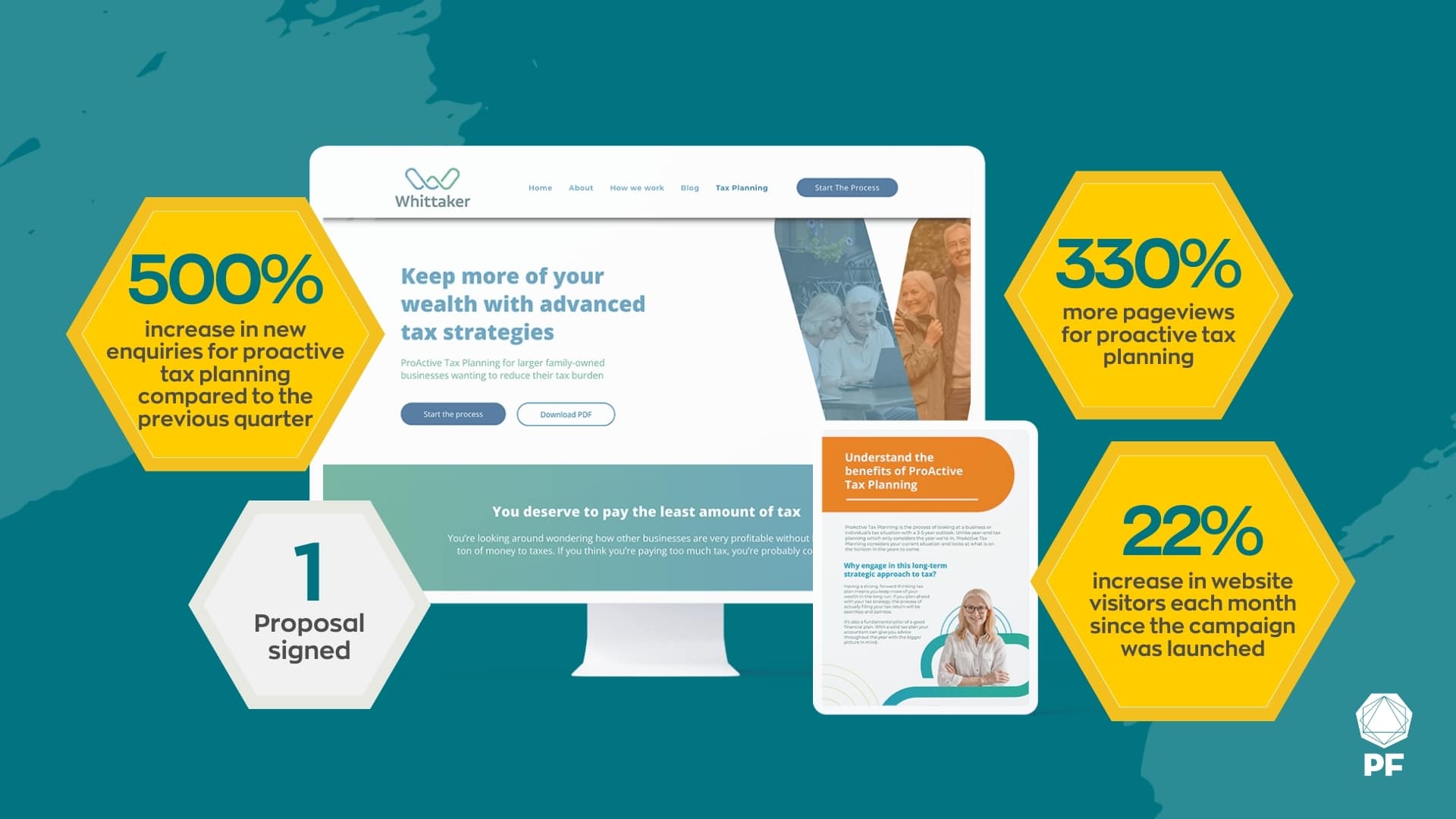
Let me introduce you to two fictional accountants: Sarah and Charlotte.
Scenario one: Sarah. Sarah’s accounting firm is doing some marketing. They’re posting on social media. They’re writing content on business and accounting topics to help their audience. They’re sending emails to clients when they have something to share. They’re pretty happy with their website. Sarah’s not sure what’s working specifically, but is putting time, energy and resources in and hoping it’ll pay off.
Scenario two: Charlotte. Charlotte’s accounting firm is engaging in goal-driven marketing. They know what they want to achieve in their firm in the next year and they have a marketing strategy with specific, measurable objectives to meet those business goals. Every time they take a marketing action (write a blog, design a social post, record a video, send an email) it’s in line with their strategy. Charlotte is measuring results and knows what’s working. Time, energy and resources are being spent on the actions with the highest chance of success.
What makes Charlotte different from Sarah? (Don’t worry, this isn’t a school maths quiz).
The answer: Charlotte’s marketing is campaigns focused.
A marketing campaign is a series of focused marketing efforts with one clear goal for a defined period of time.
A campaign takes your ideal buyer on a journey through focused steps that lead to the one final action you believe is best for them.
Let’s say you’ve been offering Xero health checks for a year or two. You’ve run the numbers and realised it’s a profitable service and it offers your clients real value.
To meet your business and personal goals this year, you’d like 6 new full-service clients. And you’ve identified the health check is a great entry point for new leads. One of the top concerns you hear from prospects is that they’re unsure whether their bookkeeping is correct. Whether they stick with you or not, your audience needs a sanity check on their books, and once they’re in the door there’s considerably more opportunity to form a deeper relationship.
So we have the business goal: 6 new full-service clients. And in quarter 1, we’re going to set a campaign goal of 4 new Xero Health Checks to support it.
We have a clear and measurable goal and a defined run time. Onto the marketing efforts….
Now we know we want to sell 4 Xero Health Checks in Q1 we consider our strategy.
- Who exactly are we targeting? What stage of business are they in? What are they experiencing? Where do they spend time online? What is their barrier to buying?
Identifying the audience, their needs and behaviours will help us figure out their journey to buying. We’d make sure we’re applying strategy to each of these four stages of buyer progression:
- Awareness: how do we show understanding of the business issues our prospects are facing that a health check would solve? Via which channels are they going to discover they need a health check?
- Consideration: What assets do we need to create to provide them with enough information to make a decision?
- Decision (time investment): What value can we provide that will allow them to trial or test the solution in their own time?
- Decision (financial investment): how and where will they go to make a purchase? How do we eliminate buyer remorse?
By deciding this we’re able to concentrate our marketing efforts. Perhaps we need a social ad… that leads to a landing page… that delivers a free demo sign up… and those emails nurture the prospect to the point of payment.
As a creative agency, this is where we get to apply strategy and our creativity. As part of the creative team, this is the sweet spot for me! We look at our client’s goals, their audience needs and the outcome we want to achieve and we ask: what’s the most creative route?
This is results-based marketing – you can’t improve without knowing and tracking the numbers.
What is measured is managed. Sound familiar?
I know it does, because tracking the numbers is your thing! By regularly monitoring your clients key metrics, you can identify areas for improvement and help them make informed decisions.
The same goes for your campaign numbers. The reason campaign marketing is so much more effective than throwing-things-at-the-wall-and-hoping-they-stick marketing is because you can:
- Identify the metrics you’re going to track beforehand
- Track them before and during your campaign so you have comparisons
- Assess: What’s going well? What’s not? What will you repeat? What will you change? What patterns can you see?
Once we’ve learned from the failures and successes of one campaign, we can decide whether we want to roll it out again, for how long and with what changes or adaptations.
To be able to see a return on your investment (ROI) of money, time, and resources we must track the metrics that matter all the way through the campaign. If we only track the big end number, for example how many leads in a defined time period, we’re unable to be agile and make changes for success. We don’t learn anything for the next round.
Here’s an example of what we tracked in a recent Tax Planning campaign for Whittaker CPA, one of our clients in the US.
Dan had identified an opportunity to sell more of their Proactive Tax Planning service. It’s profitable for the business and valuable to clients. He was proud of the results it had delivered for clients in the past, but sign ups for the service were sporadic.
Whittaker had previously created a PDF guide and a video series to market this service, but for the first few months they weren’t really seeing any results, so we came back to the drawing board and agreed that they weren’t using the assets as well as they could be.
After a request for some campaign strategy from PF, we delivered a campaign plan that would effectively promote the content Whittaker already had. We’d create awareness in the right places and nurture ideal prospects through to the point of proposal. This campaign would run for 2 months, and we’d track the following metrics:
- Views on Proactive Tax Planning Page
- PDF downloads
- Inquiries (for Proactive Tax)
- Proposals Signed
In the first two months, they’ve seen:
- 76% more page views on their Proactive Tax Planning landing page
- 22% increase in website visitors each month since the campaign was launched
- 500% increase in new inquiries for proactive tax planning compared to the previous quarter
- 5 enquiries across the 2 months
- 1 proposal signed (so far) within the first 2 months

This was a great success for the first run of this campaign, and it taught us valuable lessons about what to continue and what to change in the next run.
This example is a great lesson in the importance of tracking the right metrics in line with your goals. If Dan had continued to look at the single marketing actions (PDF guide and video series) as a failure because they weren’t getting the desired results, it could have caused him to think of it as:
- A waste of time
- Ineffective
- Not to be tried again
This lack of return can leave you feeling:
- Disheartened
- Like giving up
- Like marketing doesn’t work
- Like you were right all along, and you it’s best to allocate less resource and money to marketing next year.
We want you to see the big wins in your marketing – the sign ups, proposals, amazing clients you’d actually go for a casual kombucha with (it’s not all about beer).
That is exactly why it’s so important to run campaigns tied to your business goals, measure the small wins along the way and experiment.
Here are some campaigns you could be running to meet your business goals this year.
The campaign examples I shared in this blog were based on service- related business goals. More Xero Health checks. More Proactive Tax Planning clients…
But a marketing campaign can be strategically crafted to align with many different business goals and objectives. For example, your campaign might be to:
- Launch a big project – a new business brand, personal brand or website
- Increase sales on a service – i.e more bookkeeping clients campaign
- Increase sales on a product – i.e cash flow course campaign
- Improve customer satisfaction
- Grow your team/increase awareness of your employer brand
- Break into a new niche
- Establish a key person/key people of influence in your company
- Win an award in 2024
- Improve tax season compliance
- Repurpose or get more mileage out of a high performing asset (like a PDF guide or lead magnet)
- Raise awareness and get sign ups for an event/workshop your running
Let’s recap on the steps to follow:
Marketing campaign components:
- Define goals & objectives – work back your business goals – yearly, quarterly, monthly.
- Define audience – who is this for? What are their fears and frustrations? Look at their demographics, psychographics, buying behaviours, research the market, conduct some client interviews.
- Decide your channels – where will your messaging be distributed? Social media? Your website? Via Mailchimp?
- Plan content format and creative assets – landing page, emails, social graphics, blogs. How will these assets address your audience’s pain points and desires?
- Set a budget and allocate resources – how much do you need to spend and who will carry it out?
- Decide the metrics to track – what will you measure?
Download our FREE campaign planner to start setting this up for yourself. The PF team is on hand to help you come up with the most creative way to meet your objectives and connect with your audience. Drop us some details about your firm via our discovery form to get support with your campaign strategy and delivery.

